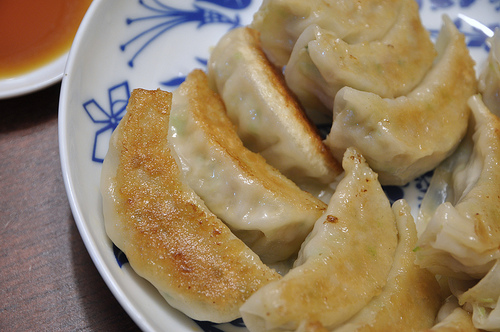If I need evidence that we like complex flavors, I will quote this passage from The New Yorker:
“This sauce is really good,” she said. “It’s so Jean-Georges. He does this French-and-Asian thing.” She warned me that she would need a few seconds to figure out its precise ingredients. (She refused to divulge them, on the ground that Vongerichten would consider the recipe “a trade secret.” I later learned from one of the waiters that the ingredients include powdered English mustard and soy sauce.) “It’s so complex,” she said. “It makes me smile.”
The soy sauce is fermented. As any regular reader of this blog knows, I believe we evolved to like complex flavors so that we would eat more bacteria-rich food. So we have something in our brain that measures complexity of smell/flavor and translates that into pleasure: the more complexity, the more pleasure.
My experience of cooking is that it isn’t easy to produce a lot of complexity using spices and stuff like garlic and ginger. It’s possible but not easy. Ordinary recipes, such as in Saveur, aim for a low level, with 5-8 spices. Chinese Five Spice has 5 spices; spice mixtures might have 8; curry powders might have 10. At Whole Foods, the ready-to-eat soups have twenty-odd ingredients. Apparently their soup designers don’t find it easy, either.
Then I discovered that miso by itself produced sufficient complexity. Miso soup doesn’t feel “under-complex”. Finally I understood why wine is such a powerful flavoring agent; wine, like miso, is fermented. It makes sense that foods that our complexity detector evolved to make us eat do a better job of setting off that detector than other foods.
Now consider how that detector works. Suppose you have two sources of sodium — two different salts, for example. You get the same saltiness from 2 g of Salt A as you do from 1 g of Salt A and 1 g of Salt B. I think complexity is quite different. I suspect that 2 g of Source A (e.g., miso) will produce a lot less complexity than 1 g of Source A and 1 g of Source B (e.g., wine).
I tried adding two fermented flavoring agents (miso and tsukudani) to soup. It worked! The result tasted clearly better than miso alone. Now I do this routinely. It’s very easy. The results have a level of deliciousness I can’t remember encountering before. Everything else I can eat (such as restaurant food) now seems less delicious. I think that three sources works better than two; whether four is noticeably better than three I don’t know.
The basic idea is there are strong sources of complexity (fermented foods) and weak ones (all other flavoring agents). One strong source = 10-20 weak sources. You get the best results by using several strong sources of complexity, perhaps three or more. Once you know this you no longer: 1. Obsess over recipe details (as in the New Yorker quote) because all complexity is alike and easily produced, just as no one worries about the source of saltiness. 2. Think traditional, time-honored recipes are better than what you can make yourself (e.g., Saveur). As far as I can tell food professionals (with one big exception) don’t understand this. I really enjoyed Top Chef Masters (a competition between 12 of the best chefs in America) but there was an almost total absence of fermented foods. Perhaps one chef used soy sauce. The winner, Rick Bayless, made a mole sauce. Mole sauces, which combine 20-odd weak sources of complexity, take hours. I think they produce less complexity than three fermented sources put together, which takes about a minute.

